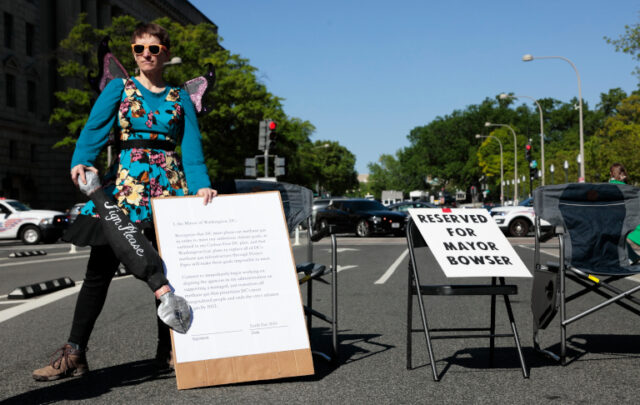Click on the headline (link) for the full text.
Many more articles are available through the Energy Bulletin homepage
Sorry Climate, I Had To Clean My Keyboard
Eric de Place, Sightline
I have an untidy habit of eating while I’m working on my computer. Heck, right now I’m eating a doughnut while I write this post.
Unfortunately, my habit inevitably results in little crumbs of sandwich or potato chips or whatever making their way onto my computer keyboard. Every once in a while I look down at my crumb-ridden keyboard, get disgusted, and then embark on a cleaning frenzy. And, as many office workers may know, one of the easiest ways to clean a keyboard is with those compressed chemical canister thingies (pictured above). So the other day, while I was merrily blasting away at my keyboard I decided to read the contents. Big mistake.
My little 10-ounce canister contains 100 percent tetrafluoroethane, a greenhouse gas that’s sometimes known as HFC-134a (meaning it’s a form of hydrofluorocarbon). Before your eyes glaze over, just keep in mind that over a 20 year period, HFC-134a is roughly 3,300 times more effective at trapping heat than carbon dioxide. Nice.
So unless I missed something in the number crunching, using up my 10-ounce can of cleaner will have the same climate-changing effect over the next 20 years as burning at least 100 gallons of gasoline. With that much gas I could drive my trusty Honda Civic from Seattle to New York City. And then back to Chicago. And I would likely still have plenty of fuel leftover for side-trips.
All that, packed into a canister retailing for $10.99 at the Office Depot around the corner.
This is not a good idea.
(26 April 2007)
Follow-up posted June 22: Dust Busting the Climate: The Sequel.
Protect your saving and beware of energy ‘vampires,’ experts warn
CBC News
Overall energy usage in houses may be on the decline as more and more consumers go green, but small energy “vampires” continue to needlessly suck up power, energy experts say.
According to the Ministry of Natural Resources, 13 million homes and 380,000 buildings across Canada are responsible for producing almost 30 per cent of the country’s greenhouse gas emissions.
By July 20, all desktop and laptop computers, workstations, servers and gaming consoles will have to meet new requirements in order to qualify for the Energy Star seal. Among other requirements, PC monitors must revert to sleep mode within 15 minutes of inactivity, while the entire computer must switch to sleep mode within half an hour of being idle.
But Ken Klassen, an efficiency expert, says consumers should still be mindful of precisely how much power electronic gadgets like printers and microwaves consume while in standby mode.
(21 June 2007)
Ionic liquid offers greener recycling of plastics
Tom Simonite, New Scientist
A way of dissolving hard-to-recycle plastics like nylon and Kevlar back to their chemical building blocks has been demonstrated by Japanese researchers.
The team thinks refinements to the process could provide a new way to completely recycle such thermosetting plastics. Other experts, however, warn that the economic and practical hurdles will be substantial.
Plastics are already recycled less often than materials like cardboard and glass, because of these difficulties. And thermosetting plastics, which cannot be heated and remoulded, are hardly ever recycled.
Tough chemical or physical treatment involving high temperatures and pressure is normally needed to break them down into reusable substances.
But chemists Akio Kamimura and Shigehiro Yamamoto at Yamaguchi University in Ube, Japan, have shown in laboratory experiments that liquid salts or “ionic liquids” can dissolve nylon back into its basic chemical units.
(21 June 2007)
Seattle mayor wants to curb landfill dependency – is recycling table scraps next?
Sharon Pian Chan, Seattle Times
First, Seattleites were told to recycle glass, paper and aluminum, or risk having their garbage left on the curb. Now the city wants residents to recycle food scraps starting in 2009.
Mayor Greg Nickels and City Councilmember Richard Conlin on Thursday proposed stricter rules for sorting trash as part of a comprehensive plan to raise the city’s recycling goals and limit the amount of trash sent to landfills.
The city currently recycles 44 percent of its garbage, and Nickels on Thursday set a goal of 60 percent by 2012 and 70 percent by 2025. In 2003, the mayor set a goal of 60 percent by 2010 but has now pushed that back two years.
“The problem with garbage fundamentally is there just is too much of it,” Nickels said at a news conference.
(22 June 2007)
Related article at Seattle Post-Intelligencer:
“This effort is going to make a huge impact,” said Heather Trim of People for Puget Sound, a non-profit group working to protect the health of Puget Sound and the Northwest straits. “We are going to have to really change the way people look at waste.”
Trim helped lead the push to persuade city leaders to ban the use of plastic foam, citing not only the amount of space it uses but the impact it has on the Sound, where it ends up as litter. Under the new resolution, the city would study the impact of a plastic foam ban.
Conlin said he wants the city to view waste as a resource — not just something to be thrown away. Ideally, all products would simply have endless cycles: Food scraps and pizza boxes would become dirt and fertilizer; tires would become filler; and products could be designed so they could be easily reused or broken down to recyclable parts.
An Inconvenient IT Truth
Michael Vizard, Ziff Davis Enterprise Group
Slide Title: What Are the Odds?
There’s a 24 percent chance that an IT organization will experience issues with power on its network.
Source: APC-MGE
Slide Title: How Much Money?
Surveys show that 48 percent of IT budgets is being spent on energy.
And 70 percent of those surveyed say power and cooling are now their biggest problem.
More than 50 percent of the power going into a typical data center goes to the power and cooling systems and NOT to the IT loads.
A 1 megawatt data center takes 177,000,000 kilowatt-hours of electricity, worth about $17,000,000 over its 10-year life (at 10 cents per kwh).
Source: APC-MGE
Slide Title: What Do They Consume?
177,000,000 kwh of Electricity
60,000,000 gallons of Water
145,000 lbs of Copper
21,000 lbs of Lead
33,000 lbs of Plastic
73,000 lbs of Aluminum
12,000 lbs of Solder
377,000 lbs of Steel
32,000,000 kwh of Primary Energy
Source: APC-MGE
Slide Title: Supply Not Meeting Demand
The power industry is not adding enough capacity to keep pace with worldwide demand.
The closer your data center is to inexpensive power sources, the better. Google is moving its data centers to the Columbia River area to save money.
States are beginning to provide utilities with financial incentives to conserve power that they are passing on to customers.
Slide Title: Cause
By 2008, 50 percent of today’s data centers will have insufficient power and cooling.
Through 2009, energy costs will emerge as the second-highest operating cost of a data center, behind labor.
Source: Gartner
Slide Title: And Effect
By 2010, half of all data centers will have to relocate or outsource applications to another facility.
Over the next five years, 90 percent of all companies will experience a power disruption.
In that same period, one in four companies will experience a significant business disruption.
But the talent pool to build and run data centers will shrink by 45 percent by 2015.
Source: Data Center Institute
Slide Title: Conclusion
Unless IT organizations take a proactive approach to green computing, they will not have the necessary dollars needed to invest in the system.
“Humans created 161 exabytes of data in 2006, approximately 3 million times the information in all the books ever written.”
— IDC
Michael Vizard is Editorial Director of the Ziff Davis Enterprise Group
(22 June 2007)
Contributor Rick Dworsky writes:
Powering the data network infrastructure aka: ‘the Internet’ will be of increasing concern in the future. We should consider how much of our financial fortune and life support system is inextricably dependent upon it… and perhaps invent some fail safe mechanisms.





